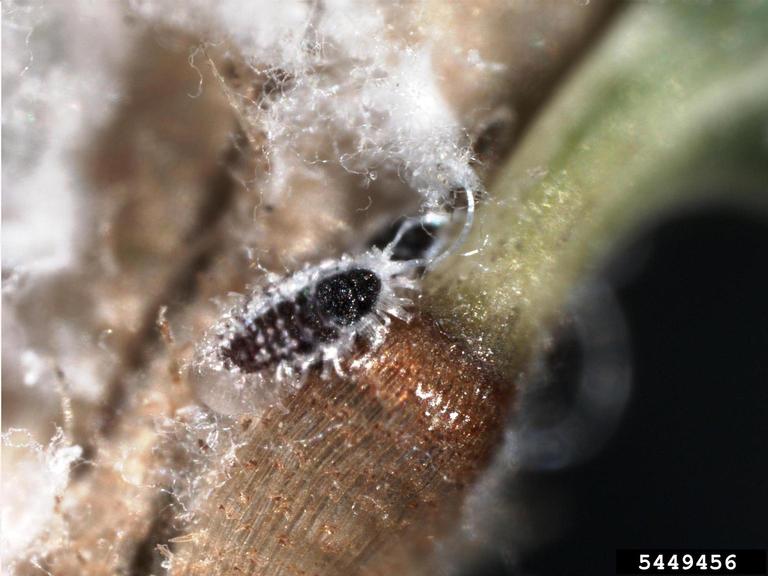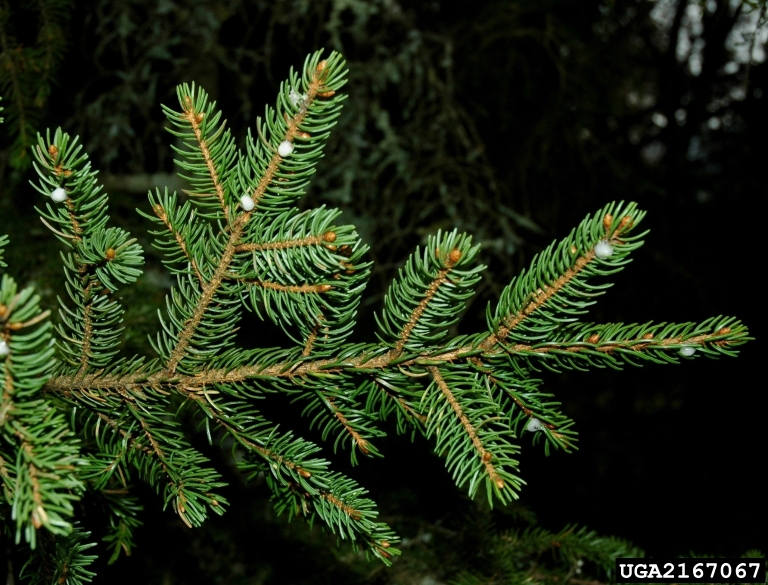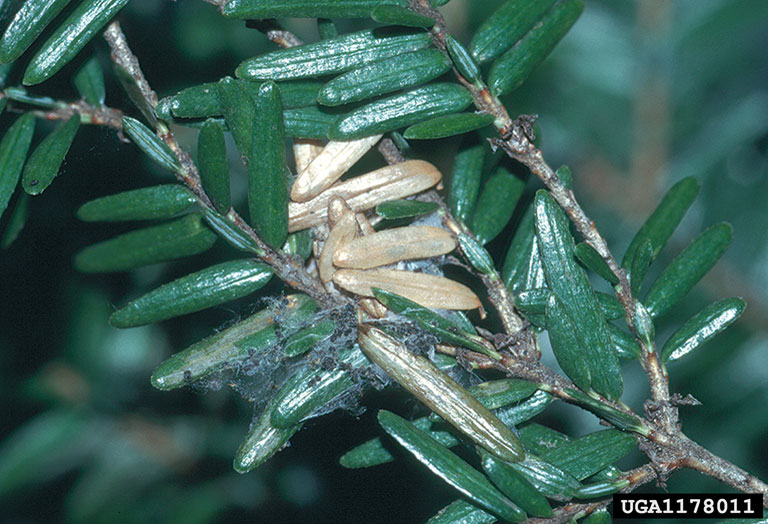
Hemlock Woolly Adelgid (Adelges tsugae)

Hemlock woolly adelgid (HWA) is an invasive insect from Japan that feeds on the sap of hemlock trees. This insect feeds by inserting its straw-like mouthparts into the base of the hemlock needles and sucking the nutrient rich sap out of the shoot. The tree’s nutrients are depleted by HWA infestations, which reduces tree vigor, desiccates needles, causes buds to die and diminishes new growth. Infested trees often die within ten years.
Biology
Hemlock woolly adelgid (HWA) completes two life cycles per year and reproduce asexually, meaning all adelgids are female. The first life cycle begins in late winter when eggs are laid. Immatures, called crawlers, hatch in early spring, and develop for about three months. Some crawlers become winged adults, which leave the hemlock in search of a suitable spruce host, but North American spruce trees do not support HWA development and these adults usually die. The other crawlers settle permanently at the base of a hemlock needle to feed and secrete a white, waxy, protective coating around themselves.
These crawlers complete development and become adults that lay eggs for the second life cycle in mid-summer. The crawlers from these eggs develop for about nine months and will either disperse to other hemlocks or remain on their birth tree. The crawlers quickly settle at the base of a needle and enter a dormant period through the hot summer months. In mid-October the crawlers become active again and resume feeding, finally maturing into adults in late winter. These insects are incredible small, measuring only about 1.5 mm and are dark reddish brown or purplish black.
Where it's from
Hemlock woolly adelgid is native to Japan and possibly China. It was first detected in the United Stated in the 1920s in the Pacific Northwest on some western hemlock. Fortunately, the western hemlocks are resistant to HWA and little damage is sustained from this pest in the west. However, in 1951 in Virginia, some eastern hemlocks were discovered to be infested. Eastern and Carolina hemlocks are not resistant to this pest and experience heavy damage and mortality.
How it spreads
The young crawlers are the only life stage of HWA that can move around before they attach to a hemlock needle to feed. These crawlers are transported to other hemlock trees by wind or animals that brush against infested trees. Long distance transportation can occur through the movement of infested trees.
Where it's found
Infestations of HWA in the eastern U.S. were initially detected in Virginia. Since its initial detection, HWA has become established in North Carolina, South Carolina, Georgia, Tennessee, Kentucky, West Virginia, Maryland, Delaware, Pennsylvania, New Jersey, New York, all New England, Nova Scotia, Ohio and Michigan.
What's being done (research, regulatory guidelines)
At least five U.S. states and Canada have quarantines in place that restrict the movement of hemlock plants and forest products from any HWA infested area. The United States Forest Service (USDA), in cooperation with other federal, state, university and private partners, is conducting research focused on outlining the scope of the problem and identifying management options. Research is underway to identify high risk areas and prioritize control efforts. Understanding the biology of HWA will contribute to discovering the best management practices which may include a combination of chemical and biological control, silvicultural strategies and breeding for resistant hosts.
Images of HWA and its damage
Early/young HWA:


Older HWA:


Images of infested hemlock trees
Early damage:

Later damage:

Look alikes





Is Hemlock Woolly Adelgid near me?

What can be done?
Management options for:
Homeowners –
Homeowners living in or near areas with confirmed HWA infestations should monitor any hemlock trees on their property for signs of HWA. If HWA is discovered on your property and you live outside the current infestation area, then immediately report the infestation to the proper local contact.
To protect infested hemlock trees on your property, you can apply systemic insecticides to the soil around the base of the trunk. Both imidacloprid and dinotefuran provide effective control and can be applied as a soil drench. An insecticidal soap or horticultural oil can also be used against HWA and usually requires two sprayings. Always follow the label instructions when applying pesticides. Some other methods for controlling HWA include watering your hemlock trees during periods of drought to reduce stress which increases the risk of insect attack. Fertilize only after HWA is controlled because nitrogen can increase HWA reproduction.
Be extra careful when moving plants, logs, firewood or bark chips from an infested area, especially from March to June when HWA are very abundant. When adding trees to your landscape, consider planting resistant ornamental varieties of hemlock. Finally, heavily infested branches on trees can be pruned and destroyed, and severely infested trees can be cut down and destroyed.
Municipalities –
Hemlock trees used in urban landscaping and planted in city parks within infested areas can be protected using pesticide treatments. Treatments with imidacloprid provide protection for at least four years and can be applied as a soil drench or trunk injection. Treatments with dinotefuran provide protection for one to two years and can be applied as a soil drench.
All hemlock trees in a forest setting cannot be protected using pesticide treatments. In this case, large, high-value forest hemlocks are selected for treatment which can prevent mortality and give biological control time to take effect. In addition to pesticide treatments, biological control has been implemented. Several predatory beetle species that feed solely on HWA have been released in infested forests, with mixed results. Silvicultural practices can be used to restore areas of forest that have been heavily impacted by HWA. Currently, efforts are being made to develop hemlock trees that are resistant to HWA, which can be utilized to restore hemlock sites.
Regulatory information
Quarantines –
Five U.S. states, including Maine, Michigan, Ohio, Vermont and Wisconsin, as well as Canada have enacted quarantines to prevent the spread of HWA. These quarantines restrict the importation of hemlock plants and plant products from areas infested with HWA. Examples of hemlock products include branches, needles, uncomposted chips, uncomposted bark, and lumber with bark. Additionally, some states, including Michigan, have internal quarantines or regulations that restrict the movement of hemlocks within the state or requires movement to be phytosanitary certified.
Who to contact
-
Connecticut - The Connecticut Agricultural Experiment Station —
- Website: https://portal.ct.gov/CAES/Publications/Publications/Hemlock-Woolly-Adelgid
- Email: carole.cheah@ct.gov
-
Delaware - Delaware Department of Agriculture —
- Website: https://agriculture.delaware.gov/forest-service/forest-health/
- Email: Bill Seybold, Forest Health Specialist, william.seybold@delaware.gov
-
Georgia - Georgia Forestry Commission —
- Website: https://gatrees.org/hemlock-woolly-adelgid-hwa-in-georgia/
- Email: Lynne Womack, Forest Health Program Manager, lwomack@gfc.state.ga.us
-
Kentucky - University of Kentucky Extension —
- Website: https://forestry.ca.uky.edu/hemlock_woolly_adelgid
- Email: forestry.department@uky.edu
-
Maine - Department of Agriculture, Conservation and Forestry —
- Website: https://www.maine.gov/dacf/mfs/forest_health/insects/hemlock_woolly_adelgid.htm
- Email: Dave Struble, State Entomologist, Maine Forest Service, dave.struble@maine.gov
- Email: Allison Kanoti, Forest Entomologist, Maine Forest Service, allison.m.kanoti@maine.gov
-
Maryland - Maryland Department of Agriculture —
- Website: https://mda.maryland.gov/plants-pests/Pages/hemlock_woolly_adelgid.aspx
- Email: Craig Kuhn, Forest Pest Management, craig.kuhn@maryland.gov
-
Massachusetts - University of Massachusetts Amherst —
- Website: https://ag.umass.edu/landscape/fact-sheets/hemlock-woolly-adelgid
- Email: ag@cns.umass.edu
-
Michigan —
- MSU Plant & Pest Diagnostics email pestid@msu.edu or call 517-355-4536 or visit https://www.canr.msu.edu/pestid/index
- Michigan Department of Agriculture and Rural Development: Email MDA-Info@michigan.gov, go to the Invasives link.
- Midwest Invasive Species Information Network’s (MISIN): use the online reporting tool or download the MISIN smartphone app and report from your phone: http://www.misin.msu.edu/tools/apps/#home, https://www.misin.msu.edu/report/misin/?project=misin
- Midwest Invasive Species Information Network (MISIN)
-
New Hampshire - New Hampshire Department of Agriculture, Markets and Food —
- Website Info: https://www.agriculture.nh.gov/divisions/plant-industry/hemlock-woolly-adelgid.htm
- Email: Douglas Cygan, Invasive Species Coordinator/Entomologist, douglas.w.cygan@agr.nh.gov
-
New Jersey - State of New Jersey Department of Environmental Protection —
- Website: https://www.state.nj.us/dep/parksandforests/forest/community/Hemlock_Woolly_Adelgid.htm
- Email: carrie.sargeant@dep.nj.gov
-
New York - New York State Department of Environmental Conservation —
- Website: https://www.dec.ny.gov/animals/7250.html
- Email: landsforests@dec.ny.gov
-
North Carolina - North Carolina State University Extension —
- Website: https://content.ces.ncsu.edu/hemlock-woolly-adelgid
- Email: Steven Frank, Professor and Extension Specialist, steven_frank@ncsu.edu
-
Ohio - Ohio Department of Agriculture —
- Website: https://agri.ohio.gov/wps/portal/gov/oda/divisions/plant-health/invasive-pests/hwa/
- Email: plantpest@agri.ohio.gov
-
Pennsylvania - Pennsylvania Department of Conservation and Natural Resources —
- Website: https://www.dcnr.pa.gov/Conservation/ForestsAndTrees/InsectsAndDiseases/HemlockWoollyAdelgid/Pages/default.aspx
- Email: PaForester@pa.gov
-
Rhode Island - Rhode Island Department of Environmental Management —
- Website: http://www.dem.ri.gov/programs/forestry/forest-health/forest-threats.php
- Email: TeeJay Boudreau, Deputy Chief, Division of Forest Environment, teejay.boudreau@dem.ri.gov
-
South Carolina - South Carolina Forestry Commission —
- Website: https://www.state.sc.us/forest/id.htm
- Email: scfc@scfc.gov
-
Tennessee - Tennessee Department of Agriculture —
- Website: https://www.tn.gov/agriculture/businesses/plants/plant-pests--diseases-and-quarantines/hwa.html
- Email: Protect.TNForests@tn.gov
-
Vermont - Agency of Natural Resources, Department of Forests, Parks, and Recreation —
- Website: https://fpr.vermont.gov/hemlock-woolly-adelgid-wood-product-considerations
- Email: Kathy Decker, Forest Protection Program Manager, kathy.decker@vermont.gov
-
Virginia - Virginia Department of Forestry —
- Website: http://www.dof.virginia.gov/health/index.htm
- Website with links to contacts for each county: http://www.dof.virginia.gov/locations/index.htm
-
West Virginia - West Virginia Department of Agriculture —
- Website: https://agriculture.wv.gov/divisions/plant-industries/forest-health-protection/
- Email: Kristen Carrington, Cooperative Forest Health Programs Coordinator, kcarrington@wvda.us
-
USDA Forest Service contacts: —
- Southern Research Station Contact:
Rusty Rhea
Forest Service-USDA
200 Weaver Blvd.
Asheville, NC 28804
Phone: 828-257-4314
Email: rrhea@fs.fed.us - Northern Research Station Contact:
Nathan Havill or Melody Keena
Forest Service-USDA
51 Mill Pond Road
Hamden, CT 06514
Phone: 203-230-4308
Email: nathan.p.havill@usda.gov or melody.keena@usda.gov
- Southern Research Station Contact: